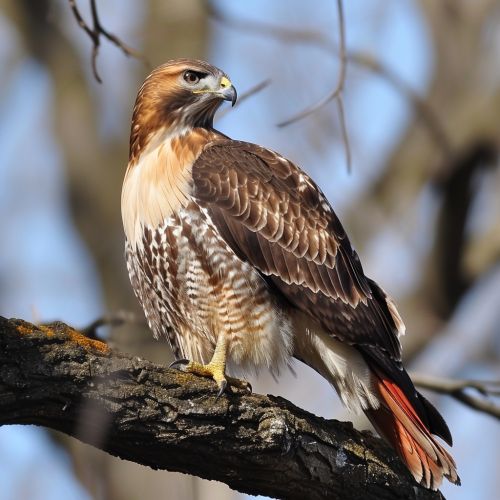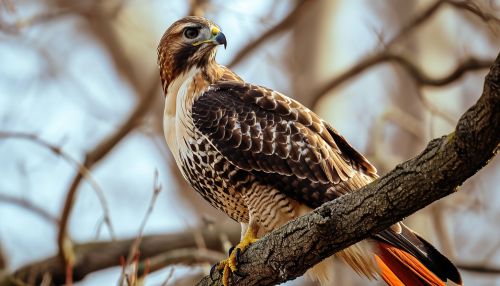Red-tailed Hawk
Introduction
The Red-tailed Hawk (Buteo jamaicensis) is a bird of prey, often referred to as a raptor, that is native to North America. It is one of the most widespread and commonly recognized members of the Buteo genus, known for their broad wings and robust bodies. The species is named for its characteristic red tail, which is visible in mature birds.


Description
Red-tailed Hawks are large birds, with a typical length ranging from 45 to 65 centimeters and a wingspan of up to 141 centimeters. They exhibit sexual dimorphism, with females being up to 25% larger than males. The bird's most distinctive feature, its red tail, is not present at birth but develops as the bird matures, usually by the second year. The tail is brick-red above and pink below, with a broad, dark band near the end.
The body of the Red-tailed Hawk is typically light with a dark brown streaked belly and a dark brown bar on the leading edge of the underwing. The plumage can vary widely based on the bird's geographic location, with variations ranging from dark brown to nearly white.
Distribution and Habitat
Red-tailed Hawks are native to North America and are found from Alaska and Northern Canada to the West Indies and Panama. They are adaptable birds and can be found in a variety of habitats, including deserts, grasslands, forests, agricultural fields, and even urban areas. They are most commonly found in open areas with high perches, which they use for hunting.
Diet and Hunting
The diet of the Red-tailed Hawk is very diverse, reflecting its adaptability and wide range. It primarily feeds on small mammals, such as mice, rats, rabbits, and squirrels. However, it is also known to eat birds, reptiles, and even insects. The Red-tailed Hawk is an opportunistic feeder and will adjust its diet based on the availability of prey.
Red-tailed Hawks hunt primarily from a perch, but will also hunt while soaring. They use their keen eyesight to spot prey, then swoop down to capture it with their sharp talons. They are powerful birds and are capable of taking down prey larger than themselves.
Breeding and Lifespan
Red-tailed Hawks are monogamous and usually mate for life. They begin breeding in their second year of life. The nesting period begins in early spring, with both the male and female participating in nest building. The nest is typically located high in a tree or on a cliff edge.
The female lays 1 to 3 eggs, which are incubated for 28 to 35 days. The chicks, or eyases, are born blind and helpless, but grow quickly. They begin to leave the nest and learn to fly, or fledge, at 42 to 46 days old.
Red-tailed Hawks have a relatively long lifespan for a bird of prey, with some individuals living up to 20 years in the wild. They have few natural predators, but can fall victim to larger birds of prey, such as eagles, and are sometimes killed by vehicles while hunting along roads.
Conservation Status
The Red-tailed Hawk is listed as a species of Least Concern by the IUCN. It has a large, stable population and a wide distribution. However, like all raptors, it is protected in the United States by the Migratory Bird Treaty Act.
